Misadventures and problems of Indian artillery
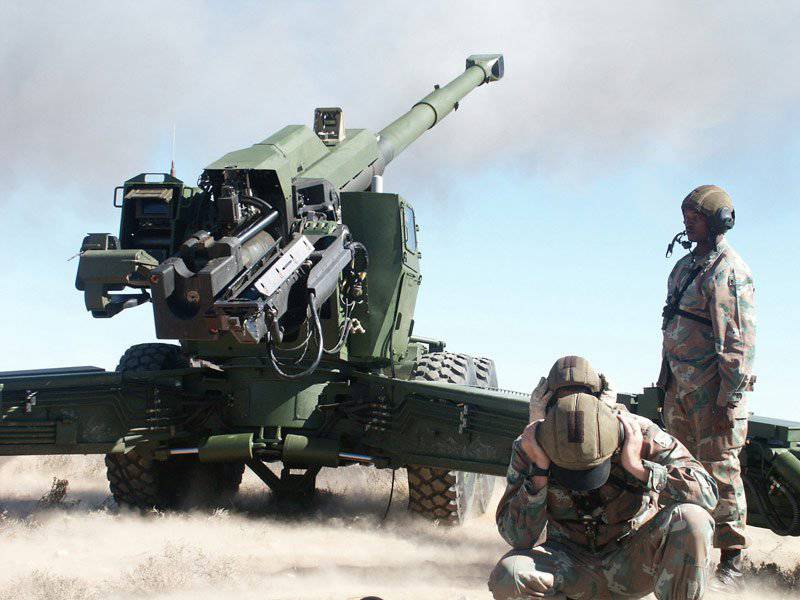
Denel applied for its howitzers G5 India back in the 90s, but was blacklisted along with several other manufacturers. Now these companies have no right to submit their applications for any of the existing Indian projects.
The artillery of the Indian army has long been confronted with longstanding corruption scandals and new procedural and bureaucratic delays, but at present it is in dire need of modernization and replacement of its materiel. Let's see how things are in this area.
Despite the experience of conducting periodic artillery duels on the Siachen Glacier and other clashes with its neighbors, who in this way reminded of their claims, the Indian Artillery Corps was in a state of neglect for a long time because plans to replace weapons more than once failed or stuck in the quagmire of administrative hell.
As a result, the Indian army now urgently needs to replace or upgrade virtually every caliber of artillery. But some positive developments can be discerned: after a long break, field tests of various 155 mm / 52-caliber guns are underway, programs for developing and upgrading howitzers in the private and public sectors are slowly but surely carried out and, finally, the process of purchasing 145 lightweight howitzers is nearing completion M777 from BAE Systems.
However, the artillery command states that these shifts are infinitely small and have little effect on the implementation of the constantly delayed rationalization plan for field artillery Field Artillery Rationalization Plan (FARP), which was launched in 1999 year and included the purchase of 3000 - 3200 howitzers of various calibers for the amount 5 - 7 billion dollars by the end of 14-th five-year financial plan of the army, ending in 2027 year.
“Delays in the procurement of artillery for more than a decade will continue to occur, with serious operational consequences,” said retired general Sheru Tapliahl. A former artillery officer warned that if the issue of procurement was not resolved immediately, the army could find itself in a situation of total loss of effective long-range fire power in stark contrast with regional opponents.
According to the FARP plan, not only artillery purchases abroad are provided for, but also the development and production of howitzers by private and state-owned joint ventures under technology transfer agreements. Will be equipped with more 200 artillery regiments, which will remain the basis of the offensive capabilities of the army "maneuver fire" and the revised combat doctrine.
The lack of howitzers, however, clearly manifested itself when the army was faced with the task of equipping two newly created mountain divisions in northeastern India as a response to the rapid build-up of Chinese military power in Tibet. The creation of an additional mountain attack corps consisting of three divisions and possibly a fourth artillery division to be deployed for the 2017 year to be deployed along an unspecified Chinese border of length 4057 km further complicates the army’s problems with howitzers.
Under the FARP program, the following purchases are planned: 1580 new towed gun systems (TGS) 155-mm / 52 caliber; 814 guns on self-propelled 155-mm / 52 chassis; and 145 finished light howitzer 155-mm / 39 caliber. The financial plan also provides for the purchase of 100-mm / 155 cal and 52 self-propelled wheeled howitzers with 180 howitzers manufactured in India under a technology transfer agreement.
At the present time, the three artillery divisions are armed with guns of six different calibers, most of which are not only outdated, but also being continuously reduced in number. These include X-NUMX-mm towed cannon D-122 and 30-mm cannon M130 of the Soviet era, as well as local Factory Board (OFB) cannons - 46-mm Indian IFG (Indian Field Gun) field cannon and its version LFG light field cannon (Light Field Gun).
Other models include howitzer Bofors FH-77B 155-mm / 39 caliber, 410 pieces of these guns were imported in the late 80-s, but less than half remain in service because of the lack of spare parts and the resulting disassembly. In total, the Israeli company Soltam and the Indian OFB have modernized the 2001 M180 cannons (46-mm / 155-caliber barrels) from 45 for the year, which has resulted in their actual range increased to 37 - 39 km.
Senior artillery officers say that, from an operational point of view, most of these guns do not meet the requirements at all, since the 17 km of actual range of IFG and LFG guns (and this is the basis of the army for more than four decades) have ceased to “meet”, since the contact boundary at the tactical level is now time is over 30 km.
In addition, neighboring armies currently have mortars with an increased range of 12 - 14 km, almost neutralizing a slightly longer IFG / LFG radius at a minimal cost. According to an anonymous artillery officer, in several places along the Pakistani and Chinese borders, the range of these guns barely allows you to cross the border of India, which makes them "ineffective."
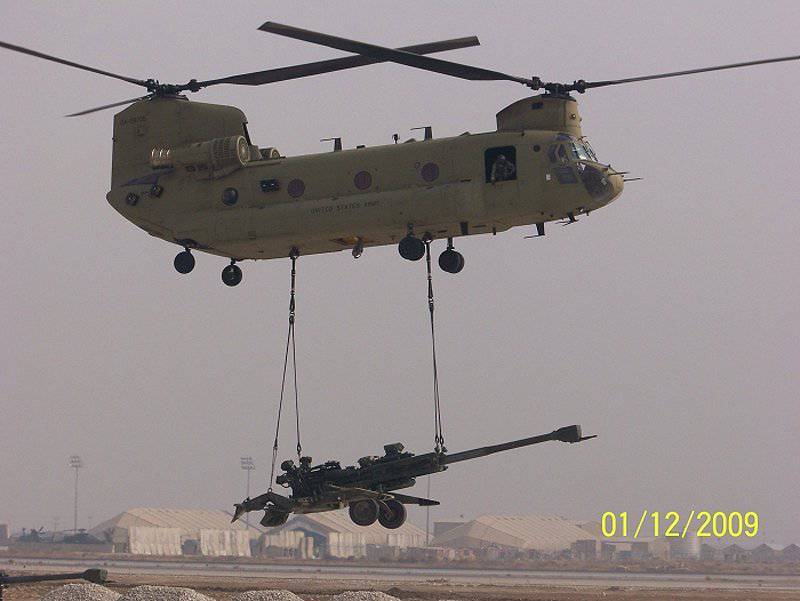
India buys a batch of lightweight howitzers M777 and ordered heavy Chinook helicopters for their quick air transport
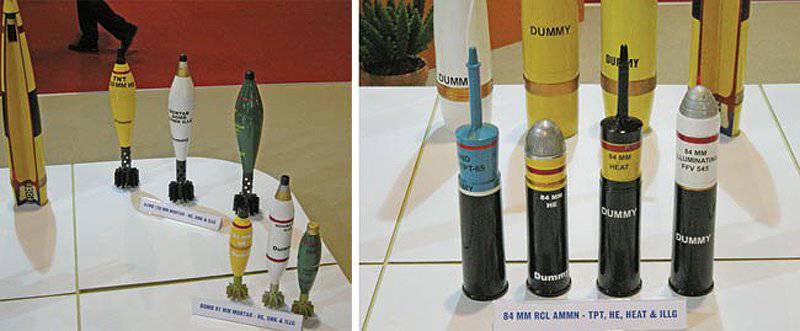
India manufactures a full range of artillery ammunition.
Big guns
In order to eliminate this “inefficiency”, in May, the 2013 of the Nexter modified TRAJAN 155-mm / 52 caliber gun from the test in the Rajasthan desert opposed the Elbit ATHOS 2052 updated howitzer. Both howitzers fired ammunition manufactured by the Indian company OFB. These tests will end with the 2014 winter shooting of the year and the choice of one of these systems by the Office of Artillery, which will continue to negotiate the final contract value (estimated budget of 2 billion dollars).
The request for proposals for a towed howitzer TGS 2011 provides that competing guns submitted to the competition must have a range of 42 km when firing various ammunition. The final contract provides for direct supply of 400 guns and an agreement on the transfer of technology for the manufacture of more 1180 systems in India; This amount is enough to equip approximately 85 regiments.
Since 2001, these tests are already the fifth attempt, four previous tests were closed by the Office of Artillery in 2006. FH-77 B05 L52 from BAE Systems, G5 / 2000 from Denel Ordnance and TIG 2002 from Soltam participated in these tests; in the first three rounds, all three howitzers and only the last two in the fourth round of tests.
Denel was excluded from further struggle after the newly elected coalition of prime minister blacklisted it in 2005. The company was accused of corruption in negotiating with the retired administration on a previous contract for 400 rifles intended to destroy the material part.
Blacklisting also led to the halt of the limited batch production of the self-propelled howitzer Bhim SPT 155-mm / 52 caliber, which included the installation of the Denel / LIW T6 tower on the Arjun MBT case of local development, which was to be manufactured by the state-owned Bharat Earth Movers Limited in Bangalore.
Nexter is currently working with Indian private contractor Larsen & Toubro (L&T), which has installed new hydraulic and related systems on TRAJAN. If selected, L&T is expected to mass-produce the entire vehicle with a high proportion of local components. According to the DPP Procurement Procedure, at least 50% of local components are considered locally made.
As part of its application, Elbit entered into an agreement with the world's largest manufacturer of forged and forged products, Kalyani Group, with headquarters in Pune. Kalyani Group - better known as Bharat Forge by the name of its most successful subsidiary - acquired a whole division for the production of artillery from the Swiss company RUAG and re-restored and launched it in the city of Pune in 2012 year. “We are at the advanced stage of development of the 155-mm / 52 TGS towed howitzer, which should be ready by the end of 2014,” said retired colonel Rahendra Sikh, executive director of Kalyani Defense and Aerospace. “We are confident that over time we will be able to meet the significant needs of the Indian army in artillery systems,” he added, highlighting the high proportion of local components in the entire project.
Kalyani Steel will provide blanks for the howitzer, while its drives, transmission and engine will be supplied by another company in the Automotive Axles group. Kalyani Steel is also open to cooperation with the state defense development organization (DRDO) and will provide know-how and software for tool management, fire correction and operational management.
The company is currently cooperating with the DRDO office in Pune, which recently received a technical assignment from the army to manufacture an advanced towed artillery gun system (2016-mm / 155) caliber ATAGS (Advanced Towed Artillery Gun System) with actual 52 km range. At the same time, an automatic loading and guidance system and propulsion system should be developed, allowing the howitzer to move independently over rough terrain over a distance of 50 meters.
The Ministry of Defense gave DRDO permission to design ATAGS and allocated 26 millions of dollars for this, but is looking for a private partnership for this project. According to Colonel Rahendra Sikh, here too Kalyani intends to submit an application, even if it competes with its own TGS.
In July, 2013 passed tests at high temperatures in support of the army’s requirements for 100 tracked howitzer SPT 155-mm / 52 cal (approximately 800 million dollars).
As part of the revived Bhim SPT howitzer project, which was halted in 2005, Rosoboronexport submitted an application based on the T-72 MBT equipped with a 152 mm / 39 cal cannon, upgraded for firing 155 mm / 52 cal. The Russians are going to fight a variant developed by the Indian company L&T based on tank K-9 "Thunder" from Samsung-Techwin.
If chosen, L&T intends to equip the SPT howitzer with a sufficient number of locally produced subsystems, such as fire control systems, communications and climate control systems, as well as to localize the hull and turret in order to obtain a “local” product.
Resuscitation FH-77B
The six prototype Bofors FH-77B 155-mm / 39 cal and 155-mm / 45 cal guns manufactured by OFB Jabalpur also tested by the customer in the Rajasthan desert in the summer of 2013, followed by another mountain test at the end of this same year.
These tests were carried out after successful factory fire tests conducted by OFB, after in October 2012, under the pressure of the army, the Ministry of Defense approved the purchase of locally-made FH-114B 77-mm / 155 towed howitzers. High army ranks noticed on this occasion that they expected an increase in the number of new howitzers to 45 units.
India acquired the 410 77-155 39 1986 cannons in 2011, along with the documentation and technology for their production, but did not reach this stage due to the fact that the acquisition of howitzers got stuck a year later in corruption scandals related to Prime Minister Rajiv Gandhi, his party and representatives of the Ministry of Defense. The investigation into this case was closed in March 21, after 2,5, a fruitless investigation that cost the federal government XNUMX a billion rupees, and no one was charged with it.
Platforms that are tested in the army include two standard FH-77B 155-mm / 39 caliber guns, two similar models with on-board computers and two howitzers 155-mm / 45 caliber. The officers involved in the FH-77B project reported that the steel for the gun barrels is supplied by the state company Mishra Dhatu Nigam, and they are processed at the OFB plant in Kanpur.
The OFB plant in Jabalpur, which manufactured IFG and LFG and upgraded Soltam’s M46 guns from the beginning of the 2000-s, will eventually start the mass production of the FH-114B 77 howitzer.
Sources in the army said that BAE Systems (which bought AB Bofors in 2005) expressed a desire to cooperate with OFB in its FH-77 project, but its share as a component supplier remains uncertain.
In accordance with the planned delivery schedule for FH-77, OFB, by special order of the Ministry of Defense, will initially deliver six guns within eight months. This will happen around the beginning of 2014, and then within three years, the company will fully transfer all 114 systems to the army.
“The acquisition of the FH-77B guns manufactured by OFB was long overdue and became an alternative to what the army and defense ministry should have done years ago,” complained General Pavar, the former commander of an artillery school in western India. “The lack of howitzers during the transition period had a significant effect on the firing power of the army.”
Industrial interference
Modernization of artillery prevented corruption scandal with FH-77B. Since 1999, the situation has not changed until the Defense Ministry launched a stunning round of recall, redistribution and reissue of the already selected howitzer proposals.
Incomplete tests and super-ambitious performance requirements issued by the Artillery Department for the purchase of new platforms and the modernization of existing ones, further impeded the process of modernization.
For example, the FH-77BS upgrade program to 155-mm / 45 feces was stopped in the 2009 year after performance requirements were determined to be unreachable. To perform them, it was necessary to replace the barrel, bolt, strengthen the lower carriage and install a modern sighting system.
“Some of the modernization requirements were simply unrealistic for these 25-year-old guns,” said an industry source associated with this project, “they were asked for opportunities that were not available to newer howitzers.” The army and the defense ministry did not want to revise the requirements or reduce the parameters, even though many in the management of artillery assumed that they were unrealistic. Even at BAE Systems, despite the status of the leading manufacturer of howitzers, they refused to respond to the request for modernization requirements due to "overwhelming performance requirements."
In addition, it complicated the case on the already limited market of artillery systems, the black list of the Ministry of Defense 2005 of the year, in which, as a result of corruption charges for the term of 10, three main suppliers of howitzers were entered. In addition to Denel, outlaws included the Swiss Rheinmetall Air Defense (RAD) and Singapore Singapore Kinetics (STK). All of them were already at an advanced stage of either carrying out operational tests or negotiating relevant contracts for howitzers. All three companies deny any wrongdoing and challenge the corresponding prohibitions in various ways.
“Blacklisting of suppliers reduces competition and deprives the army of main armament, which in turn strikes its combat readiness,” said General Mrinal Suman, the largest specialist in procurement of materiel and offset kits. New tenders conducted in accordance with the complex and non-transparent Procurement Procedures for the Indian Authority (DPP) only lead to even greater delays and higher costs.
The words of General Suman briefly reflect the position of the Parliamentary Committee on Defense and the General Auditor and Auditor, who have repeatedly reproached the Defense Ministry for compromising the combat capabilities of the army due to the delayed purchase of howitzers. In the December report of 2011, the Auditor General in Parliament categorically stated that the purchase of howitzers "is not foreseen in the near future."
India is currently purchasing more than 75% of its defense needs abroad, and most of the current officers admit that such a radical change in defense procurement policies could further hinder the already delayed modernization in the military sphere, especially artillery.
In the revised DPP Order, emphasis is placed on the development and production of local weapons systems, while purchases abroad are referred to as “extreme measures”. It also expresses confidence in increasing the share of the private sector in the Indian military-industrial complex, monopolized for decades by public organizations such as DRDO, 40 divisions of OFB and eight more so-called defense enterprises of the public sector of India.
Accordingly, the Defense Ministry published a request for proposals in September 20113 of the year for the modernization of 300 M46 guns to the 155-mm / 45 caliber standard as part of a program in which OFB and four private defense contractors, as well as their selected foreign suppliers, will take part.
After Soltam and OFB completed the Project Karan project, the army, in the face of the constant delays in its FARP program, resurrected the program to modernize Soviet M46 due to the fact that it still has 300 - 400 with these 130- mm guns. The Artillery Directorate argued that since the guns were mainly removed from service and form part of the “Free Issue Material” army reserves, the modernization will be not only effective, but also economical.
M46 enhancements
India was the largest exporter of Moscow M46 guns (developed in 1948 year). Since the end of the 60s, 800 units have been purchased and already in 1971 year they were successfully applied in a conflict with Pakistan. In search of more firepower in October 2009, the desperate Artillery Administration even considered importing an unnamed number of M46 guns from the ex-Soviet republics surplus, but later rejected the proposal.
In early 2012, the Army approached the OFB, Kalyani Group, L&T, Punj Lloyd and the Tata Power Strategic Engineering Division (SED) to bring the M46 cannons to the 155mm / 45 caliber standard under the Buy and Make (Indian) category (Buy and make (Indian)) ”from the DPP Order. Under this rule, local public and private companies can be selected to form joint ventures with foreign manufacturers to design and manufacture weapons systems for the Indian army.
The head of Tata Power SED, Raul Choudry, said that all four private companies had submitted their feasibility reports on upgrading M46 for the Defense Ministry in March 2012 in response to his limited request for information sent to them earlier. They are currently awaiting a request for proposals.
Immediately after the request is published, the army will provide each candidate with one M12 cannon for modernization during the 46 months, after which they will take part in competitive trials. However, it is not clear today whether one or two candidates from five candidates will be selected, who will then take over the whole process of modernization.
While the Kalyani Group has teamed up with Elbit to upgrade the M46, L&T is partnering with Nexter in this direction. OFB already has experience with the previous Karan project, while Tata Power SED and Punj Lloyd have entered into agreements with Eastern European countries, including Slovakia and the former Soviet republics, which are very familiar with the M46 cannons.
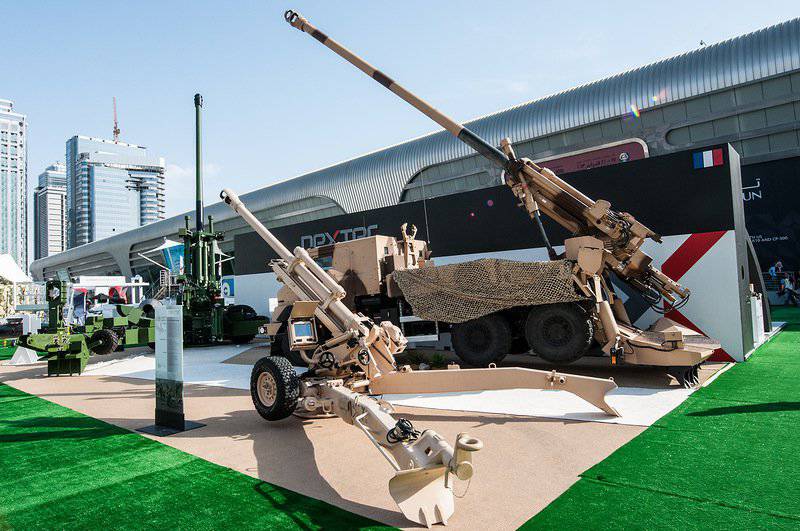
In the foreground, modernized by Nexter and Larson and Toubro, gun M46 of Soviet origin
However, all private contractors are cautious about the special conditions of the upcoming DPP, fearing that state-owned enterprises will again be given preference for tax exemptions, which constitute about a third of the total project cost. “As long as the government does not fulfill its promise to the private sector, its participation in the military sector will remain minimal, limited to only small and medium-sized enterprises producing components and subassemblies,” Choudhry drew attention to this.
Even with this in mind, the majority agrees that the private sector will remain dependent on the government on artillery systems, because it is not allowed to produce these systems and, therefore, it is unable to carry out tests during the development of artillery and similar platforms.
Tata Power SED, for example, is awaiting the approval of the Defense Ministry regarding the shooting and ammunition landfills in order to conduct fire tests of its MGS 155-mm / 52 howitzer, which has been developed in the past five years at a factory in Bangalore. Choudry said that Tata Power SED has teamed up with many local and foreign prototype production partners, which was shown in New Delhi in December 2012 of the year. He stated that the MGS howitzer had been subjected to advanced firing tests in South Africa before Tata Power SED supplied an unspecified number of howitzers to the Indonesian army, but this deal ultimately did not take place.
“At present, we have asked the Indian Army for permission to conduct technical howitzer firing in order to test its effectiveness and accuracy,” said Chaudry, confident that this would help her qualification and MGS 814 howitzers finally come into service more than 40 regiments.
He said that this system was the first howitzer of local development with a valid range of approximately 50 km, since it contains 55% of local parts with the most important know-how in ballistic technology and related systems developed in collaboration with the Indian industry. However, other technologies, such as the inertial instrument navigation system, were taken from partners from Eastern Europe and Africa (apparently from Denel), but Chowdry refused to name them or howitzer development costs, which he said were “significant”.
Choudhury also declined to comment on cooperation with banned foreign manufacturers of howitzers, such as Rheinmetall, who collaborated with Tata Power SED on various defense projects before falling into rogue states. He also said that his company had “planned” the entire technological process and the supply chain of components for the howitzer and was awaiting the results of technical firing before offering it to the army.
“Expanding the private sector is vital for building and manufacturing local military systems,” said Choudhury. Without this, all kinds of troops will remain dependent on imports.
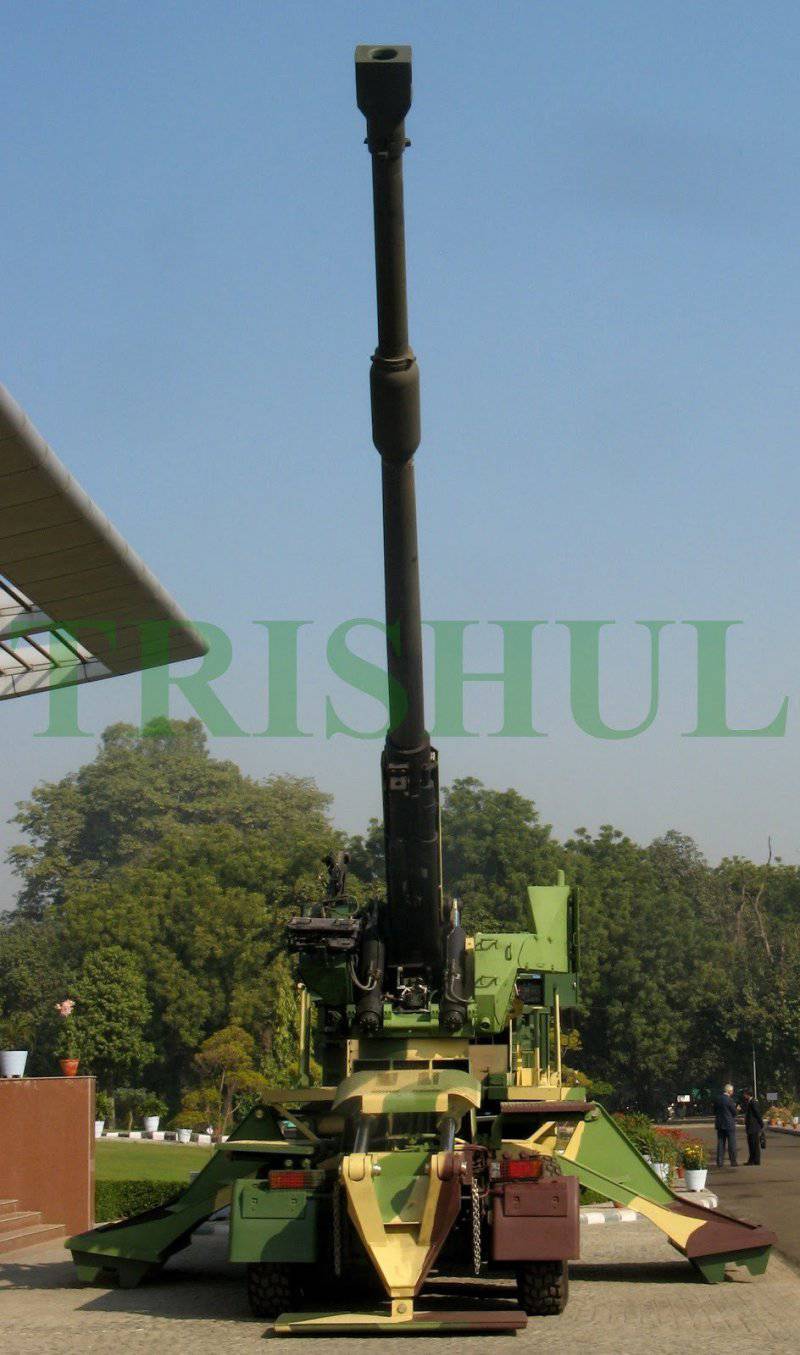
The 155 mm / 52 Tata MGS howitzer from Tata has been developed for five years at a factory in Bangalore
Arjunia Arjun
As another measure to address the shortage of artillery systems, the DRDO organization in July 2013 launched the second round of "confirmatory" tests in Rajasthan of its self-propelled artillery system, obtained by installing the M46 gun on the Arjun Mk I OBT chassis
The first round of running and fire tests of the Catapult M46 Mk II hybrid gun, developed by one of the DRDO units in Chennai, was successful, after which the Defense Ministry approved the mass production of 40 platforms. However, the artillery control wants to conduct a second round of tests on the Arjun Mk II chassis. The production of 40 new Catapult platforms is expected to start around the middle of 2014; all of them will go into service with two artillery regiments.
These platforms will replace the same number of Catapult Mk I self-propelled units. They were manufactured in 80's, when the M46 gun was installed on an extended chassis manufactured under a licensed OBT Vijayanta (Vickers Mk I). The army wants to deploy them along the Pakistani border in the state of Punjab.
In the crazy Arjun of the Catapult Mk II system, the driver’s seat is kept, but in the center of the chassis there is an open area for the gun and a crew of eight, and on top there is a square metal roof to protect against attacks from above. The 130-mm Catapult Mk II cannon is installed with a fixed vertical angle of 14,5 ° and has an effective range of 27 km, but can only fire from a spot. She can carry ammunition from 36 shots.
Project manager Mr. Srithar said that the Catapult Mk II is heavier with a MTU 838 Ka-510 diesel engine with an 1400 horsepower Xp. It is a more efficient option compared to the previous light version with a Leyland 535 hp engine. and has a more effective recoil system.
Club M777
Meanwhile, the Indian army is inevitably approaching the purchase of an 145 towed M777 155-mm / 39 lightweight howitzer from BAE Systems [see Note 1] and laser inertial targeting systems LINAPS (Laser Inertial Artillery Pointing Systems) under a contract worth 647 million dollars. After the delegation’s trip to the US in January 2013 to discuss all the delivery formalities, including the assessment of maintainability, the process got off the ground.
These tests followed the US Department of Defense’s request to the US government in November 2012 for the purchase of M145 howitzers and LINAPS systems as part of the sales program weapons and military equipment to foreign countries for arming seven regiments in two new mountain divisions.
However, senior officers say that it is expected to increase the demand for light howitzer on 280 - 300 guns in order to arm the future attack corps and artillery division. M777 howitzers will be transported by heavy Boeing CH-47F Chinook helicopters, which the Indian army bought 15 units in October 2012 of the year (the deal has not yet been signed).
Sources at the Ministry of Defense reported that the final round of negotiations on the contract price, spare parts and maintenance, and the further signing of the contract should take place in the current fiscal year ending in March 2014 of the year.
“The process [of negotiations between the two governments] is proceeding at a good pace, and we hope for a timely result,” a BAE Systems spokesman said, but declined to say whether the contract is part of the program to sell weapons and military equipment to foreign countries. The company had previously stated that they could begin supplying M777 howitzers within 18 months after signing the contract.
And as usual, the acquisition process is not going smoothly yet. Initially, M777 competed with the STK's lightweight Pegasus 155-mm / 39 caliber, but the latter was blacklisted in June 2009, and the litigation with STK caused the suspension of the process of purchasing light howitzers for more than two years. In the end, no court decision was made, the case was closed in April 2012, and negotiations with the US on the delivery of M777 howitzers were resumed.
Here you need to mention another event that negatively affected the M777 procurement process. The classified results of the "confirming" firing tests of the M777 howitzer conducted in the middle of 2010 were anonymously reported to the Army headquarters in February of 2012. This information forced the now former army commander General Singh to halt the M777 acquisition process on the grounds that those tests showed poor results when firing 155-mm Indian-made ammunition. All this hype questioned the entire project, but in the end, the information from the published report was found to be unconvincing.
A year later (in 2012), a request for information on 180 155-mm / 52 self-propelled howitzers of a caliber was sent out after the Defense Ministry declared invalid the 2010 tests of the year involving the wheeled 48-ton howitzer Rheinmetall Wheeled Gun-52 and the Slovak shKH Zuzuz alleged “deviations from the test procedure”.
The Defense Ministry canceled the tests after the army submitted its test report, which stated that the barrel of the Slovak gun had exploded during the tests. The details are classified, but Rheinmetall has also been blacklisted, and the process of purchasing self-propelled howitzers has remained in limbo.
The army’s problems are added by an acute shortage of ammunition for all artillery systems, including 50000 155-mm precision projectiles, more than 21200 two-module charging systems and about one million electronic detonators and a shortage of many other positions.
In recent years, the army has successfully introduced Shakti, an artillery command and control system. This large and important system includes a global network of military tactical computers that provide decision-making for all operational artillery functions in the command chain, starting with the artillery corps and ending with artillery batteries. The system is also designed to integrate seamlessly into integrated network-centric battle management systems that are currently being developed and tested in the military.
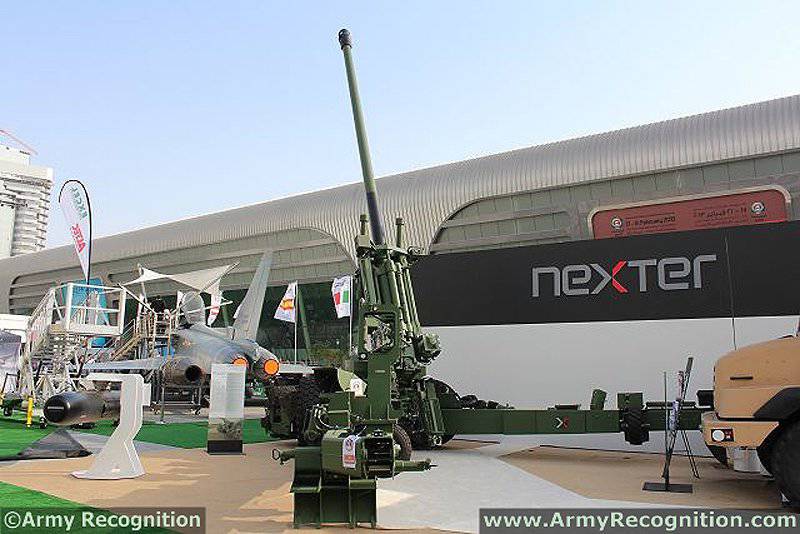
India is testing the TRAJAN howitzer 155 by Nexter, modified by local contractor Larson and Toubro. This howitzer competes for an Indian order with an ATHOS 2052 howitzer developed by the Israeli Elbit
[Approx. 1] At the time of publication of the article, it was reported that the Ministry of Defense of India had postponed the signing of a contract with the British company BAE Systems for the supply of 145 howitzers 777 caliber 155 millimeters. Reports about it Defense News. The reason for the suspension of negotiations was the intention of the British company to extend the deadline for the fulfillment of offset obligations from four to six years. According to the Defense Procurement Council (DAC) of the Ministry of Defense of India, there is no talk of abandoning the purchase of the M777.
According to Indian law, foreign suppliers of weapons and military equipment are required to reinvest in the Indian economy up to 30 percent of the transaction amount. The Indian Ministry of Defense insisted on the inclusion in the contract of a clause according to which BAE Systems would be obliged to fulfill the offset obligations within four years from the moment of signing the agreement.
The Indian Defense Ministry decided to purchase the M777 howitzers in 2010 year. Preliminary negotiations on the supply of guns have already taken place, but the contract has not yet been signed. During the negotiations, the cost of 145 guns for India increased from 493 to 885 million dollars; cost increase was mainly due to inflation. Initially, India planned to buy howitzers from Singapore Technologies Singapore Technologies, but this company was put on the “black list” of suppliers on charges of bribing.
Materials used:
Jane's International Defense Review
www.defensenews.com
www.defencenews.in
www.drdo.gov.in
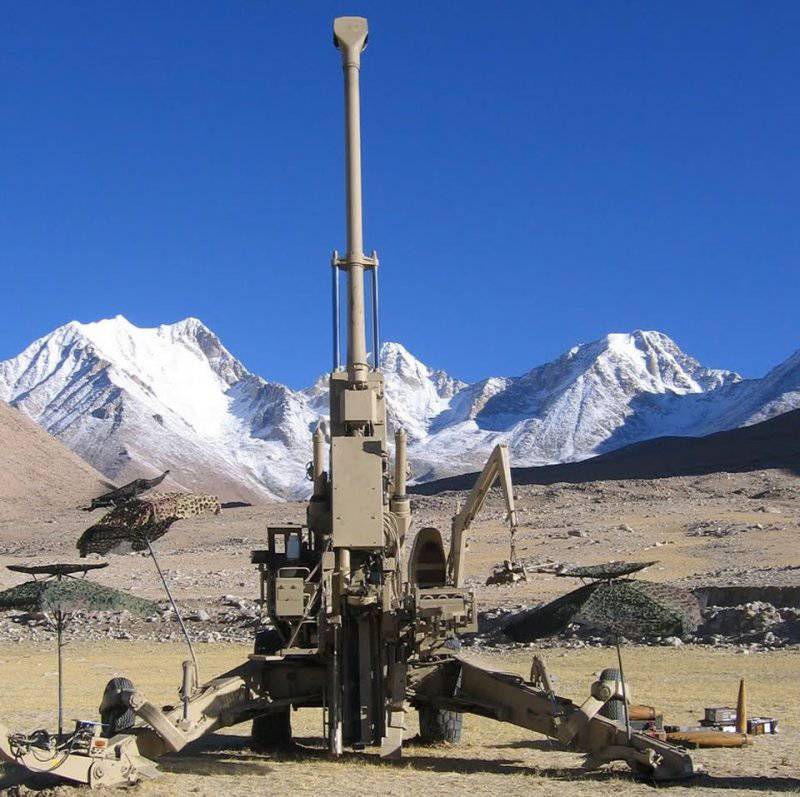
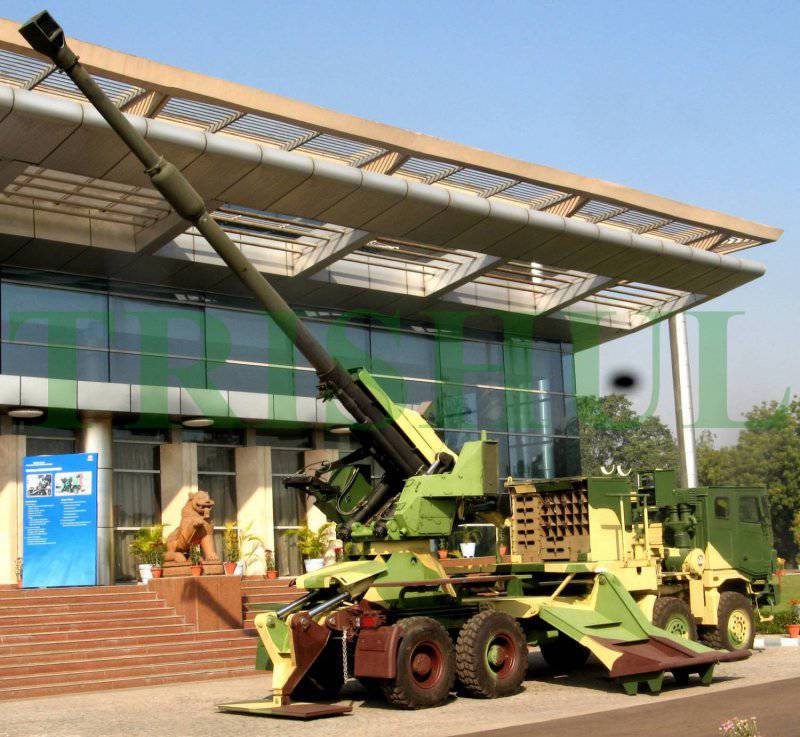
Information